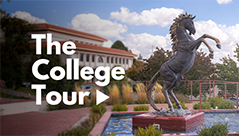Danielle Romero never imagined she would devote her career to studying the Mimbres culture of the American Southwest. Romero, the Director of WNMU Museum, began her graduate degree in anthropology at the University of Nevada, Las Vegas with an interest in Egyptian ceramics. In February, however, Romero was excited to receive into the museum’s collection a substantial donation of Mimbres artifacts, including numerous items from the Elk Ridge Ruin in the Mimbres valley.
“This is the second largest collection for the museum besides NAN Ranch,” said Romero, referring to the museum’s collection of the largest and most complete body of materials in existence from a single prehistoric Mimbres site. Like the NAN Ranch collection, Romero said, the new donation is an “academic collection with field notes and context information that will be available to researchers.”
The donation came from Human Systems Research (HSR), a nonprofit archeological organization based in Las Cruces. In addition to the Elk Ridge collection, the artifacts donated by HSR include items from a ruin near Animas Creek in Sierra County and pieces from an earlier prehistoric site in the Mesilla Valley.
Romero is no stranger to the Elk Ridge Ruin, having conducted extensive field research there while working on her doctorate from UNLV. While Romero’s research has focused on the part of the ruin that is federally owned and operated by the National Forest Service, the newly acquired collections include artifacts from land that is privately owned.
Ruins such as those at Elk Ridge are often the site of excavation by property owners and other collectors untrained in archeological methods. This type of excavation led the New Mexico legislature in 1989 to make it a felony to disturb grave sites on public or private land, and soon after Congress passed the federal Native American Graves Protection and Repatriation Act in 1990. Immediately prior to these laws taking effect, however, the ruins at Elk Ridge were damaged by a bulldozer that was used to quickly unearth as many prehistoric pots as possible.
Luckily, some of the pueblo rooms were buried too deeply for the bulldozer to easily reach. The museum’s new collection represents archeological excavations that salvaged what the bulldozer left behind at Elk Ridge. The collection includes numerous ceramics from the Late Pithouse and Mimbres Classic periods (approximately AD 600-1130) and a stone bench, the first of its kind found among Mimbres ruins. Animal bone and plant samples from the site have revealed the first evidence of turkey domestication in the Mimbres Valley as well as a bone from what is believed to be an Amazona parrot.
While the museum already houses artifacts from Elk Ridge, the acquisition “represents the second step of being able to bring all the Elk Ridge collections under one roof,” said Romero.
Ultimately, Romero intends the Elk Ridge artifacts to be featured as part of the museum’s permanent exhibit. In displaying the collection, Romero hopes to highlight the unfortunate history of looting and unscientific pot collection in the American Southwest, as well the efforts that are currently being made to recover the archeological record of sites like Elk Ridge and to better understand the Mimbres people.
Discover the new collection at the WNMU Museum.


